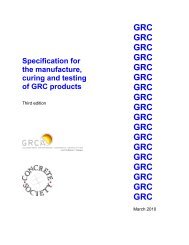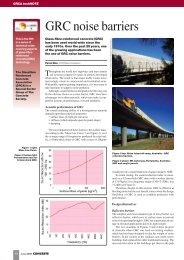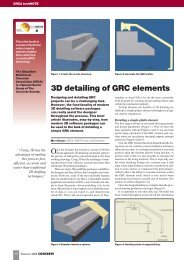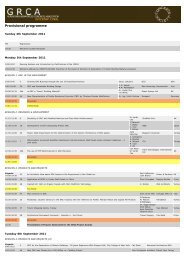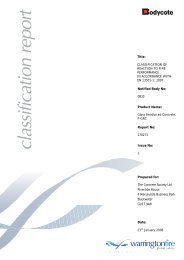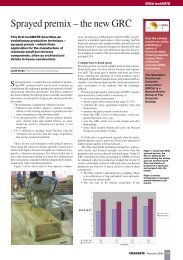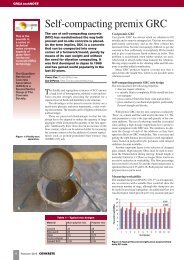GRC In Action - The Concrete Society
GRC In Action - The Concrete Society
GRC In Action - The Concrete Society
Create successful ePaper yourself
Turn your PDF publications into a flip-book with our unique Google optimized e-Paper software.
<strong>GRC</strong> <strong>In</strong> <strong>Action</strong><br />
Today’s <strong>GRC</strong> for Architects and Engineers<br />
Glassfibre Reinforced <strong>Concrete</strong> (<strong>GRC</strong>)<br />
is a material that is making a significant<br />
contribution to the economics, technology<br />
and aesthetics of the construction industry<br />
worldwide
<strong>GRC</strong><br />
Contents<br />
<strong>In</strong>troduction 3<br />
<strong>GRC</strong> in Architecture 4<br />
Cladding 5<br />
Features and Mouldings 6<br />
Landscaping 7<br />
<strong>GRC</strong> in Building 8<br />
Roofing 9<br />
Walls and Windows 10<br />
Renovation 11<br />
Foundations and Floors 12<br />
Modular Building 13<br />
<strong>GRC</strong> in Engineering 14<br />
Permanent Formwork 15<br />
Utilities 16<br />
Acoustics 17<br />
Bridges and Tunnels 18<br />
Water and Drainage 19<br />
Technical Appendix 20<br />
This publication has been prepared by the <strong>In</strong>ternational Glassfibre Reinforced <strong>Concrete</strong> Association.<br />
Its aim is to give architects, engineers, and other construction professionals an insight into the<br />
wide range of applications of <strong>GRC</strong> currently being executed throughout the world.<br />
* <strong>GRC</strong> is also known as GFRC is some countries
<strong>GRC</strong><br />
<strong>In</strong>troduction<br />
Glassfibre Reinforced <strong>Concrete</strong> (<strong>GRC</strong>*) is one of the most versatile<br />
building materials available to architects and engineers.<br />
Developed in the twentieth century, <strong>GRC</strong> has been making a significant<br />
contribution to the economics, technology, and aesthetics of modern<br />
construction worldwide for over 30 years.<br />
<strong>GRC</strong> is not a single material but a family of high-performance<br />
cement-based composites reinforced with special alkali resistant<br />
glass fibres, which can be engineered to suit a wide range of<br />
applications.<br />
<strong>GRC</strong> products can be formed into sections as thin as 6 mm ( 1 / 4 inch)<br />
so their weight is much less than traditional precast concrete products.<br />
<strong>The</strong> design and manufacture of <strong>GRC</strong> products is covered by international<br />
standards, which have been developed in Europe, America, Asia and<br />
Australasia. <strong>GRC</strong> is manufactured in over 100 countries.<br />
3
<strong>GRC</strong><br />
in Architecture<br />
<strong>GRC</strong> presents architects and engineers with a material from which the<br />
most ambitious designs can be created. It can be moulded to form<br />
modern futuristic designs or to replicate traditional historic features.<br />
<strong>GRC</strong> can be painted, faced with fine aggregates, coloured or simply<br />
left with a natural white or grey, smooth or textured finish.<br />
Key features<br />
<strong>GRC</strong> products are lightweight, easy to handle and fast to erect<br />
<strong>GRC</strong> products reduce loadings on buildings leading to significant<br />
savings in superstructure and foundations<br />
<strong>GRC</strong> is excellent for reproduction and renovation<br />
<strong>GRC</strong> is environmentally friendly<br />
<strong>GRC</strong> provides the designer with a complete technology that few other<br />
materials can match for versatility.<br />
4
<strong>GRC</strong><br />
Cladding<br />
<strong>GRC</strong> is one of the most popular materials used for creative prefabricated architectural<br />
cladding. <strong>GRC</strong>’s ability to be moulded into thin, lightweight panels with a wide variety<br />
of shapes, forms and surface finishes has been appreciated by a growing audience of<br />
architects and engineers worldwide.<br />
Key features<br />
<strong>GRC</strong> is easily moulded to reproduce shapes, details and textures<br />
<strong>GRC</strong>’s high strength allows design of thin, lightweight cladding elements<br />
<strong>GRC</strong> can be coloured with pigments, paints and natural stone facings<br />
<strong>GRC</strong> cladding can replace non-structural precast concrete where weight<br />
and/or shape may be problematic<br />
<strong>GRC</strong> cladding panels are generally manufactured by the ‘Hand Spray’ technique.<br />
As the name implies, the material is sprayed into a mould using special machinery.<br />
<strong>The</strong> method can produce high-performance materials from which panels with<br />
extremely thin, lightweight sections are achievable.<br />
5
<strong>GRC</strong><br />
Features and Mouldings<br />
<strong>GRC</strong> products are formed by a variety of manufacturing techniques. One of the most<br />
versatile is to cast the composite in moulds manufactured from rubber, timber or Glassfibre<br />
Reinforced Plastic (GRP/FRP). This is known as Premix <strong>GRC</strong>. As the high-performance<br />
alkali resistant glass fibres are evenly distributed in the mix, the material is reinforced<br />
throughout, enabling products with the finest of details to be created.<br />
<strong>GRC</strong> is used to produce beautiful architectural mouldings and features. Whilst often<br />
cast with thicknesses in excess of 25 mm these products remain easy to handle and<br />
erect, and permit the architect or engineer an unrivalled freedom for creative design.<br />
Key features<br />
<strong>GRC</strong> can be cast into fine details<br />
<strong>GRC</strong> offers designers unrivalled flexibility<br />
<strong>GRC</strong> mouldings and features are easy<br />
to handle and erect<br />
<strong>GRC</strong> does not suffer from<br />
corrosion of the reinforcement.<br />
Unlike traditional concrete, <strong>GRC</strong><br />
does not require a minimum<br />
of concrete cover to the<br />
reinforcement.<br />
<strong>GRC</strong> does not suffer from corrosion<br />
6
<strong>GRC</strong><br />
Landscaping<br />
<strong>In</strong> building projects, leisure facilities, urban renewals and municipal schemes<br />
ever-increasing attention is being focused on the built environment. <strong>GRC</strong> is playing<br />
a major role.<br />
Key features<br />
<strong>GRC</strong> is environmentally friendly<br />
<strong>GRC</strong> is durable against extreme weather conditions<br />
<strong>GRC</strong> products are lightweight and easy to handle<br />
<strong>GRC</strong> offers a wide variety of shapes and surface finishes<br />
Seating, planters, receptacles, kiosks, bollards, signs, statues and fountains, to name<br />
but a few, all benefit from being made in <strong>GRC</strong> with its ability to tailor shape, form<br />
and surface finish and to be aesthetically compatible with the chosen environment.<br />
<strong>GRC</strong> also provides theme park and zoological architects with a medium through which<br />
they can turn dreams into reality. Many of the world’s largest theme parks and zoos use<br />
<strong>GRC</strong> to create rockscapes, replica buildings, simulated environments for animals, and<br />
much more.<br />
7
<strong>GRC</strong><br />
in Building<br />
<strong>In</strong> recent years, a shortage of skilled workers combined with the need<br />
to produce lighter weight building components has led to significant<br />
advancements in the use of prefabricated <strong>GRC</strong> elements. Builders<br />
worldwide are appreciating the increase in speed of construction that<br />
<strong>GRC</strong> provides.<br />
Furthermore, engineers are discovering that small additions of alkali<br />
resistant glass fibres can benefit the quality of traditional concrete<br />
elements, whether precast or cast in-situ. Research has shown that<br />
high-modulus alkali resistant glass fibres can help to control cracking<br />
and improve durability.<br />
Key features<br />
<strong>GRC</strong> is easy to mould<br />
<strong>GRC</strong> is fast to fix<br />
<strong>GRC</strong> is durable<br />
<strong>GRC</strong> is crack resistant<br />
8
<strong>GRC</strong><br />
Roofing<br />
<strong>GRC</strong> is an ideal material to use on a variety of roofing structures. It is lightweight but<br />
tough, easy to fix and unaffected by environmental conditions. It can imitate traditional<br />
roofing materials such as slate, natural stone or clay products but unlike these materials<br />
it is neither heavy nor brittle.<br />
<strong>GRC</strong> can be moulded into complex shapes for roofing accessories such as finials,<br />
ridges and chimneys. It is non-combustible with a high impact strength and can be<br />
used on all types of roof.<br />
Corrugated <strong>GRC</strong> sheets, used for industrial and agricultural roofing, are manufactured<br />
by automated processes, offering strength and impact performance benefits.<br />
Key features<br />
<strong>GRC</strong> is impact resistant<br />
<strong>GRC</strong> can reproduce colour and finish<br />
<strong>GRC</strong> products are lightweight<br />
<strong>GRC</strong> has excellent durability<br />
9
<strong>GRC</strong><br />
Walls and Windows<br />
Key features<br />
<strong>GRC</strong> is easily moulded<br />
<strong>GRC</strong> products are quick to install<br />
<strong>GRC</strong> is durable and crack resistant<br />
<strong>GRC</strong> offers a wide range of surface finishes<br />
<strong>GRC</strong>’s versatility enables it to be used in different ways in the construction and<br />
decoration of building walls. <strong>In</strong> its simplest form, <strong>GRC</strong> renders reinforced with alkali<br />
resistant glass fibres can be used on a variety of substrates to provide a durable and<br />
decorative finish. <strong>The</strong>y may be applied over external insulation as part of a system to<br />
upgrade the thermal characteristics of the wall, directly onto blockwork or masonry,<br />
or onto metal lath. <strong>In</strong> all cases the glassfibre reinforcement gives a long-lasting and<br />
crack-free performance.<br />
Moulded <strong>GRC</strong> components such as window sills, window surrounds, cornices, doorportals<br />
and columns can add decoration to residential and commercial buildings while also<br />
meeting functional needs. Standard prefabricated panels incorporating a choice of<br />
surface finish including<br />
exposed aggregate, natural<br />
stone and brick effect are<br />
possible.<br />
10
<strong>GRC</strong><br />
Renovation<br />
<strong>GRC</strong> is an ideal material for use in renovation.<br />
Thin lightweight panels are easy to fix and minimise the weight imposed on the existing<br />
structure. <strong>In</strong> many cases the opportunity is taken not only to improve the aesthetics of<br />
the building but also to improve the thermal and acoustic properties.<br />
<strong>GRC</strong>’s ability to be moulded and finished with natural materials means that traditional<br />
architectural forms can be maintained when required.<br />
Key features<br />
<strong>GRC</strong> preserves historic features<br />
<strong>GRC</strong> improves aesthetics<br />
<strong>GRC</strong> reduces the load on existing<br />
structures<br />
<strong>GRC</strong> enables thermal and acoustic<br />
properties to be upgraded<br />
11
<strong>GRC</strong><br />
Foundations and Floors<br />
<strong>GRC</strong> can provide practical solutions in the construction of foundations and floors.<br />
As permanent formwork under suspended, in-situ concrete floors it can give economic<br />
benefits together with excellent appearance. <strong>In</strong> balcony slab construction, <strong>GRC</strong> can<br />
provide a pre-finished moulded edge while simplifying construction. On ground floor<br />
concrete slabs, insulated <strong>GRC</strong> edge formwork can help in minimising heat loss from the<br />
building in cold climates. Similarly, in wall construction insulated <strong>GRC</strong> base course<br />
and sill units can be incorporated, which contribute to the overall wall insulation<br />
performance.<br />
On the construction site, forms of glassfibre-modified concrete can be used in floor<br />
screeding, both in relatively thick concrete screeds and in thin self-levelling overlays.<br />
Key features<br />
<strong>GRC</strong> permanent formwork protects<br />
concrete<br />
<strong>GRC</strong> floor screeds and overlays offer<br />
improved crack resistance over<br />
traditional finishes<br />
<strong>GRC</strong> insulated products improve<br />
thermal performance<br />
<strong>GRC</strong> improves concrete durability<br />
12
<strong>GRC</strong><br />
Modular Building<br />
<strong>The</strong> qualities of <strong>GRC</strong> are shown to great advantage in the area of modular building.<br />
<strong>GRC</strong> panels are light and easily transported but also resistant to damage. Small units<br />
such as modular bathrooms or telecommunications equipment housings can be shipped<br />
in one piece and rapidly lifted into position. <strong>The</strong> strength of <strong>GRC</strong> is sufficient so that,<br />
even in thin skin construction, small modular buildings can be designed without heavy<br />
structural frames.<br />
<strong>GRC</strong> walls can incorporate thermal insulation if required, while the absence of steel<br />
reinforcement can be a benefit in electrical or telecommunications applications.<br />
Aesthetically, the full range of natural and applied finishes, and freedom of design,<br />
which characterise <strong>GRC</strong> permit solutions to satisfy any architectural requirement.<br />
Key features<br />
<strong>GRC</strong> enables rapid construction<br />
<strong>GRC</strong> products are lightweight and portable<br />
<strong>GRC</strong> provides a turn-key solution<br />
<strong>GRC</strong> products can improve thermal performance<br />
13
<strong>GRC</strong><br />
in Engineering<br />
Compared to traditional concrete, <strong>GRC</strong> offers the engineer an unrivalled<br />
range of material properties. <strong>GRC</strong> is not a single material. Its properties<br />
can be engineered to suit each application. For example, for products<br />
such as permanent formwork, high short-term strength is required.<br />
While for utility and drainage products light weight combined with<br />
durability give <strong>GRC</strong> a considerable advantage.<br />
Key features<br />
<strong>GRC</strong> is durable<br />
Examples of engineering<br />
applications can be found<br />
worldwide.<br />
<strong>GRC</strong> is lightweight<br />
<strong>GRC</strong> is easy to handle and transport<br />
<strong>GRC</strong> is fast to install<br />
14
<strong>GRC</strong><br />
Permanent Formwork<br />
More than 2 million square metres of <strong>GRC</strong> permanent formwork have been used over<br />
the years. <strong>The</strong> most popular application is in bridge construction. Small (1-2 m span)<br />
<strong>GRC</strong> panels are fitted between precast concrete beams before steel reinforcement and<br />
concrete are placed. <strong>GRC</strong> permanent formwork panels are not only fast to install, they<br />
also provide extra corrosion protection to the steel reinforcement. <strong>GRC</strong> carbonates very<br />
slowly and has low permeability providing a barrier to the ingress of de-icing salts.<br />
<strong>GRC</strong> permanent formwork has also proved to be an efficient solution to the world’s<br />
ageing sewers. <strong>In</strong> the UK, France, Holland and elsewhere thousands of kilometres of<br />
brick-built sewers have been lined with <strong>GRC</strong> permanent formwork and grouted in<br />
place. Not only does this safeguard the structural integrity of the sewer but also the<br />
smooth surface of the <strong>GRC</strong> enhances the hydraulic performance.<br />
<strong>In</strong> building construction, <strong>GRC</strong> permanent formwork has been used in innovative ways<br />
to produce complex forms and shapes.<br />
Key features<br />
<strong>GRC</strong> is easy to mould<br />
<strong>GRC</strong> is fast to install<br />
<strong>GRC</strong> provides protection to the steel<br />
reinforcement in the concrete<br />
<strong>GRC</strong> ensures a consistent finish<br />
<strong>GRC</strong> decorative finishes can be created in<br />
factory conditions before installation<br />
15
<strong>GRC</strong><br />
Utilities<br />
Opportunities to take advantages of <strong>GRC</strong>’s inherent durability in the utility industries<br />
abound. <strong>GRC</strong> provides protection against both man-made and natural environmental<br />
hazards.<br />
<strong>In</strong> the railway industries, <strong>GRC</strong> ducts run alongside the lines to protect both electrical<br />
and communication cables. Railway engineers internationally appreciate the advantages<br />
of lightweight, high-strength units that can be installed many times faster than the<br />
traditional concrete equivalents.<br />
<strong>GRC</strong> not only offers functional solutions in such applications; it also provides designers<br />
with the opportunity to enhance the environment. Many producers offer a wide range<br />
of finishes from natural texture to imitation stone.<br />
Key features<br />
<strong>GRC</strong> is durable<br />
<strong>GRC</strong> provides a high level of<br />
protection<br />
<strong>GRC</strong> products are lightweight<br />
<strong>GRC</strong> is environmentally friendly<br />
16
<strong>GRC</strong><br />
Acoustics<br />
<strong>GRC</strong> has found favour with acoustics engineers worldwide as a primary choice for<br />
both internal and external acoustic barriers and screens.<br />
<strong>GRC</strong>’s high density, smooth surface finish and ability to be easily moulded have been<br />
used to advantage in concert halls and other auditoria.<br />
<strong>In</strong> road and railway construction, <strong>GRC</strong> noise barriers, which can either disperse or<br />
absorb sound, have provided nearby residents with a better environment.<br />
<strong>GRC</strong> not only offers functional solutions in such applications, it also gives designers<br />
the opportunity to create interesting features that enhance the aesthetics.<br />
Key features<br />
<strong>GRC</strong> improves the environment<br />
<strong>GRC</strong> disperses or absorbs sound<br />
<strong>GRC</strong> is ideal for elevated structures<br />
<strong>GRC</strong> enhances the aesthetics<br />
17
<strong>GRC</strong><br />
Bridges and Tunnels<br />
Lightweight, durable <strong>GRC</strong> elements are frequently used in the world of bridges and<br />
tunnels. <strong>GRC</strong> parapet panels are used to provide aesthetically pleasing architectural<br />
features without burdening the structure with excessive weight.<br />
<strong>GRC</strong> tunnel lining panels are normally noted for their contribution to the architecture<br />
of the structure. <strong>GRC</strong> panels can be manufactured with thin sections, which means<br />
that the encroachment into the open space of the tunnel is minimised.<br />
Key features<br />
<strong>GRC</strong> products are lightweight<br />
<strong>GRC</strong> is fire resistant<br />
<strong>GRC</strong> products are fast to fix<br />
<strong>GRC</strong> is functional and aesthetic<br />
18
<strong>GRC</strong><br />
Water and Drainage<br />
<strong>GRC</strong>’s high strength enables products with thin sections to be manufactured. <strong>The</strong>se<br />
products are considerably lighter in weight than their counterparts made from normal<br />
concretes. Advantages, in addition to the inherent durability of <strong>GRC</strong>, are that the products<br />
are easy to handle and fast to install. Furthermore, <strong>GRC</strong> units can be manufactured<br />
with dense smooth surfaces that minimise resistance to water flow.<br />
Product weight is a critical health and safety issue in many countries. Limits on the<br />
weights that individual workers can carry often mean that the heavier traditional<br />
concrete alternatives are not acceptable. <strong>GRC</strong> products can be designed to be as little as<br />
one-fifth of the weight of a comparable precast concrete product. A 100-kg concrete<br />
product requires mechanical lifting; a 20-kg <strong>GRC</strong> product is a one-man lift.<br />
Key features<br />
<strong>GRC</strong> is easy to handle and transport<br />
<strong>GRC</strong> is strong and durable<br />
<strong>GRC</strong> is fast to install<br />
<strong>GRC</strong> has low resistance to water flow<br />
19
<strong>GRC</strong><br />
Technical Appendix<br />
<strong>GRC</strong> is a family of materials that can be defined by the addition rate of alkali resistant<br />
glass fibre. At one end of the spectrum low dosages of dispersible fibres are used to<br />
control plastic shrinkage cracks in normal concretes (PCR). At the other end, integral<br />
fibres are used at high dosage levels to reinforce cement-rich mortars (<strong>GRC</strong>).<br />
Fibre contents for different <strong>GRC</strong> product types (kg of fibre per m 3 of concrete)<br />
100<br />
80<br />
60<br />
40<br />
20<br />
0<br />
Plastic<br />
Shrinkage<br />
Crack<br />
Resistant<br />
(PCR)<br />
<strong>Concrete</strong><br />
Fibre-<br />
Modified<br />
<strong>Concrete</strong><br />
Fibre-<br />
Modified<br />
Render<br />
Premix <strong>GRC</strong><br />
Sprayed <strong>GRC</strong><br />
Most <strong>GRC</strong> products are manufactured by one of two processes – Vibration Casting<br />
and Spraying.<br />
<strong>The</strong> vibration cast form is normally referred to as “Premix <strong>GRC</strong>”. Premix <strong>GRC</strong><br />
is produced in a two stage process. A mixture of cement, sand, water and chemical<br />
admixtures is first prepared in a high speed mixer. Fibres are added in the second<br />
stage with a slower speed. <strong>The</strong> Premix <strong>GRC</strong> is then poured into moulds and<br />
compacted by vibration.<br />
Sprayed <strong>GRC</strong> is sometimes called “Hand Spray <strong>GRC</strong>” or “Machine Spray <strong>GRC</strong>”<br />
depending on the method of manufacture. A mixture of cement, sand, water and<br />
chemical admixtures is prepared in a high shear slurry mixer. This is then placed in<br />
a machine that conveys the slurry to a special spray gun where the fibres are added<br />
at the nozzle as the <strong>GRC</strong> material is sprayed onto a mould.<br />
A third production process called “Spray Premix” is also often used for the manufacture<br />
of smaller elements and the application of renders.<br />
20
<strong>The</strong> strength of Sprayed <strong>GRC</strong> is generally higher than Premix <strong>GRC</strong>.<br />
<strong>The</strong> table below shows typical values for Sprayed <strong>GRC</strong> and Premix <strong>GRC</strong> manufactured<br />
with 5% and 3% (by weight of mix) alkali resistant glass fibre.<br />
Property Hand or Machine Vibration Cast<br />
Spray <strong>GRC</strong> Premix <strong>GRC</strong><br />
Glassfibre Content<br />
by Weight of Mix 5% 3%<br />
Bending:<br />
Ultimate Strength (Modulus of Rupture – MOR) MPa 20–30 10–14<br />
Elastic Limit (Limit of Proportionality – LOP) MPa 7–11 5–8<br />
Tension:<br />
Ultimate Strength (Ultimate Tensile Strength – UTS) MPa 8–11 4–7<br />
Elastic Limit (Bend Over Point – BOP) MPa 5–7 4–6<br />
Shear:<br />
<strong>In</strong>terlaminar Shear Strength MPa 3–5 N.A.<br />
<strong>In</strong>-plane Shear Strength MPa 8–11 4–7<br />
Compressive Strength MPa 50–80 40–60<br />
Impact Strength kJ/m 2 10–25 10–15<br />
Elastic Modulus GPa 10–20 10–20<br />
Strain to Failure % 0.6–1.2 0.1–0.2<br />
Dry Density Tonne/m 3 1.9–2.1 1.8–2.0<br />
Hand Spray Spraying Premix Vibration Cast<br />
<strong>GRC</strong> <strong>GRC</strong> render Premix <strong>GRC</strong><br />
21
<strong>GRC</strong> and the Environment<br />
<strong>The</strong> main constituents of <strong>GRC</strong> are based on the naturally occurring earth oxides that<br />
are used in the manufacture of cement and glass fibres. <strong>The</strong>se are not generally<br />
regarded as pollutants. Wash water from the manufacturing process contains cement<br />
and this is alkaline. It is normal for factories to have settlement tanks so that solids<br />
do not enter the drainage system.<br />
Eco-95 Weighted average environmental impact<br />
160<br />
140<br />
120<br />
100<br />
% 80<br />
60<br />
40<br />
20<br />
<strong>GRC</strong> (100)<br />
Precast concrete (161)<br />
<strong>GRC</strong> (100)<br />
Precast concrete (157)<br />
0<br />
Cable Ducts<br />
Drainage Channels<br />
<strong>The</strong> reduced weight of <strong>GRC</strong> compared to steel reinforced concrete products does<br />
provide environmental benefits. An assessment carried out as part of a UK government<br />
DETR/<strong>Concrete</strong> <strong>In</strong>dustry Alliance ‘Partners in Technology’ project compared two<br />
precast concrete and <strong>GRC</strong> products that fulfil the same function. <strong>The</strong> results show<br />
that <strong>GRC</strong> has a lower environmental impact.<br />
<strong>The</strong> main reasons for the reduced environmental impact of <strong>GRC</strong> compared to<br />
traditional precast concrete are:<br />
• Reduced cement usage per product<br />
• Reduced transport costs<br />
22
Sources of <strong>In</strong>formation, Specifications and Recommendations<br />
Standards<br />
EN 1169: 1999: Precast concrete products - General rules for factory production<br />
control of glass-fibre reinforced cement products.<br />
EN 1170: 1998: Parts 1–8 Precast concrete products: Test methods for glass-fibre<br />
reinforced cement.<br />
EN 14649: 2005: Precast concrete products - Test method for strength retention of<br />
glass fibres in cement and concrete (SIC TEST).<br />
(Further standards are in preparation (2006) to cover a Specification for the alkali<br />
resistance of glassfibre products for reinforcement of cements and concretes (future<br />
standard EN 15422) and a Classification of glassfibre reinforced concrete<br />
performance (future standard EN 15191).<br />
<strong>GRC</strong>A Publications<br />
<strong>The</strong> <strong>In</strong>ternational <strong>GRC</strong>A also issues its own Guidance documents including:<br />
Specification for the Manufacture, Curing and Testing of <strong>GRC</strong> Products, 2000.<br />
Practical Design Guide for Glassfibre Reinforced <strong>Concrete</strong>, 2005.<br />
Current publication details are available from <strong>The</strong> Bookshop within <strong>The</strong> <strong>Concrete</strong> <strong>Society</strong>:<br />
Telephone: 07004 607777 (UK only) or +44 (0)1276 607140 (international calls)<br />
Email: enquiries@concretebookshop.com<br />
Website: www.concretebookshop.com<br />
<strong>In</strong> addition, the <strong>In</strong>ternational <strong>GRC</strong>A holds a database of past <strong>GRC</strong>A Congress<br />
Proceedings and many other <strong>GRC</strong> related publications and books.<br />
<strong>In</strong>formation can be obtained from the Bookshop or <strong>GRC</strong>A Advisory Service,<br />
Email: info@grca.co.uk<br />
Designed and produced by Liquorice Suite, England +44 (0)117 908 5448<br />
Publications of other organisations<br />
Prestressed <strong>Concrete</strong> <strong>In</strong>stitute (PCI) USA<br />
Telephone: +1 312 786 0300<br />
Website: www.pci.org<br />
Recommended Practice for Glass Fiber Reinforced <strong>Concrete</strong> Panels - Fourth Edition, 2001.<br />
Manual for Quality Control for Plants and Production of Glass Fiber Reinforced<br />
<strong>Concrete</strong> Products, 1991.<br />
National Precast <strong>Concrete</strong> Association of Australia (<strong>GRC</strong> <strong>In</strong>dustry Group)<br />
Telephone: +61 (029890) 8853<br />
Email: info@npcaa.com.au<br />
Website: www.npcaa.com.au<br />
Design, Manufacture and <strong>In</strong>stallation of Glass Reinforced <strong>Concrete</strong> (<strong>GRC</strong>), 1999 (in revision)<br />
<strong>The</strong> <strong>In</strong>ternational <strong>GRC</strong>A has relationships with other associations connected with the<br />
<strong>GRC</strong> industry. Further information together with a full list of members can be found<br />
on the <strong>In</strong>ternational <strong>GRC</strong>A website: www.grca.co.uk<br />
© <strong>In</strong>ternational Glassfibre Reinforced <strong>Concrete</strong> Association 2006<br />
Any recommendations contained herein are intended only as a general guide and, before being used in connection with any report or specification, they<br />
should be reviewed with regard to the full circumstances of such use. Although the <strong>In</strong>ternational Glassfibre Reinforced <strong>Concrete</strong> Association as a special<br />
sector group of <strong>The</strong> <strong>Concrete</strong> <strong>Society</strong> ensures every care has been taken in the preparation of this document, no liability for negligence or otherwise can<br />
be accepted by <strong>The</strong> <strong>Concrete</strong> <strong>Society</strong>, the members of its working parties, its servants or agents. All rights reserved. No part of this publication may be<br />
reproduced, stored in a retrieval system or transmitted in any form or by any means, electronic, mechanical, photocopying, recording or otherwise without<br />
the prior permission in writing of the <strong>Concrete</strong> <strong>Society</strong>.<br />
23
Glassfibre Reinforced <strong>Concrete</strong> Association<br />
<strong>The</strong> <strong>Concrete</strong> <strong>Society</strong> • 4 Meadows Business Park • Station Approach • Blackwater • Camberley GU17 9AB • UK<br />
Tel: +44 (0)1276 607140 • Fax: +44 (0) 1276 607141 • Email: enquiries@concrete.org.uk • Web: www.concrete.org.uk<br />
<strong>GRC</strong>A Advisory Service Tel: +44 (0)870 3505 607 • Email: info@grca.co.uk • Web: www.grca.co.uk<br />
<strong>The</strong> Glassfibre Reinforced <strong>Concrete</strong> Association<br />
is a special sector group of <strong>The</strong> <strong>Concrete</strong> <strong>Society</strong>



